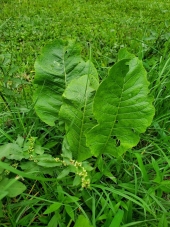
 6
6





Striving to grow things as naturally, simply, and cheaply as possible! 
My YouTube channel
 5
5





Striving to grow things as naturally, simply, and cheaply as possible! 
My YouTube channel
 2
2








Dan Allen wrote:Looks like a baby Seminole type with the white veins.

Striving to grow things as naturally, simply, and cheaply as possible! 
My YouTube channel
 6
6




A human being should be able to change a diaper, plan an invasion, butcher a hog, conn a ship, design a building, write a sonnet, balance accounts, build a wall, set a bone, comfort the dying, take orders, give orders, cooperate, act alone, solve equations, analyze a new problem, pitch manure, program a computer, cook a tasty meal, fight efficiently, die gallantly. Specialization is for insects.
-Robert A. Heinlein
 1
1





Striving to grow things as naturally, simply, and cheaply as possible! 
My YouTube channel
 2
2





Striving to grow things as naturally, simply, and cheaply as possible! 
My YouTube channel
 6
6





Striving to grow things as naturally, simply, and cheaply as possible! 
My YouTube channel
 4
4




 2
2




Cj Jones wrote:Thanks so much for posting these, Steve. It's astounding to see the progress from the may shot of the fledgling plants making first true leaves. Your growth rate is incredible. A testament to your soil and how happy they are shading/helping each other. Looking forward to trying this intensive method!
 No watering, weeding, or major pest or disease problems so far, just planting, observing, and harvesting. It makes gardening so much more enjoyable to me!
No watering, weeding, or major pest or disease problems so far, just planting, observing, and harvesting. It makes gardening so much more enjoyable to me! 
Striving to grow things as naturally, simply, and cheaply as possible! 
My YouTube channel
 2
2





Striving to grow things as naturally, simply, and cheaply as possible! 
My YouTube channel
 3
3






Striving to grow things as naturally, simply, and cheaply as possible! 
My YouTube channel
 1
1




Striving to grow things as naturally, simply, and cheaply as possible! 
My YouTube channel




Striving to grow things as naturally, simply, and cheaply as possible! 
My YouTube channel
 2
2




 1
1





Striving to grow things as naturally, simply, and cheaply as possible! 
My YouTube channel
 1
1




Striving to grow things as naturally, simply, and cheaply as possible! 
My YouTube channel
 2
2




“We can complain because rose bushes have thorns, or rejoice because thorn bushes have roses.” — Abraham Lincoln
 2
2




Apartment-dwelling hopeful future permie
 2
2




“We can complain because rose bushes have thorns, or rejoice because thorn bushes have roses.” — Abraham Lincoln
 1
1




Jen Fulkerson wrote: I just try to help keep the soil as healthy as I can, and I plant as much as I can get in a space, veggies, herbs, and flowers. It looks like a messy jungle, but I have very little pest problems and get amazing production, at least the last couple of years.
Striving to grow things as naturally, simply, and cheaply as possible! 
My YouTube channel
 2
2








 1
1




 1
1




 1
1




 2
2




Steve Thorn wrote:Big little baby squash plant!

These squash were planted by simply scattering the seed on the soil and doing a light mixing of the seeds into a thin mulch layer on top.
They won't be watered at all this year except by the rain.
I time the planting of the seeds right before a rain, so that they get watered in naturally soon after being planted.
 2
2








Striving to grow things as naturally, simply, and cheaply as possible! 
My YouTube channel




 2
2




 4
4




 2
2




 2
2




 1
1




 and want their to be as many opportunities for genetic diversity as possible to hopefully strengthen the next generation.
and want their to be as many opportunities for genetic diversity as possible to hopefully strengthen the next generation.
Striving to grow things as naturally, simply, and cheaply as possible! 
My YouTube channel
 2
2




Steve Thorn wrote:I also wouldn't thin them either as long as there is enough room.
Even if there wasn't enough room I'd still probably let them grow, I admit I'm a plant genetics hoarder,and want their to be as many opportunities for genetic diversity as possible to hopefully strengthen the next generation.
I usually let my plants go and the strongest survive on their own. Sometimes the late starters will catch up to the first plants and be even better so I always hate to cull them until I get a better idea of how they will do. My thinking too as far as developing squash landraces, is that it's better to have a lot of seedlings with a few squash on each one than to have a few plants with a lot of squash on each plant. If the plant is able to produce a crop the first year I want to let it, that way I have more options to select for when creating the landrace for the future!

|
girl power ... turns out to be about a hundred watts. But they seriously don't like being connected to the grid. Tiny ad:
Rocket Mass Heater Resources Wiki
https://permies.com/w/rmh-resources
|









